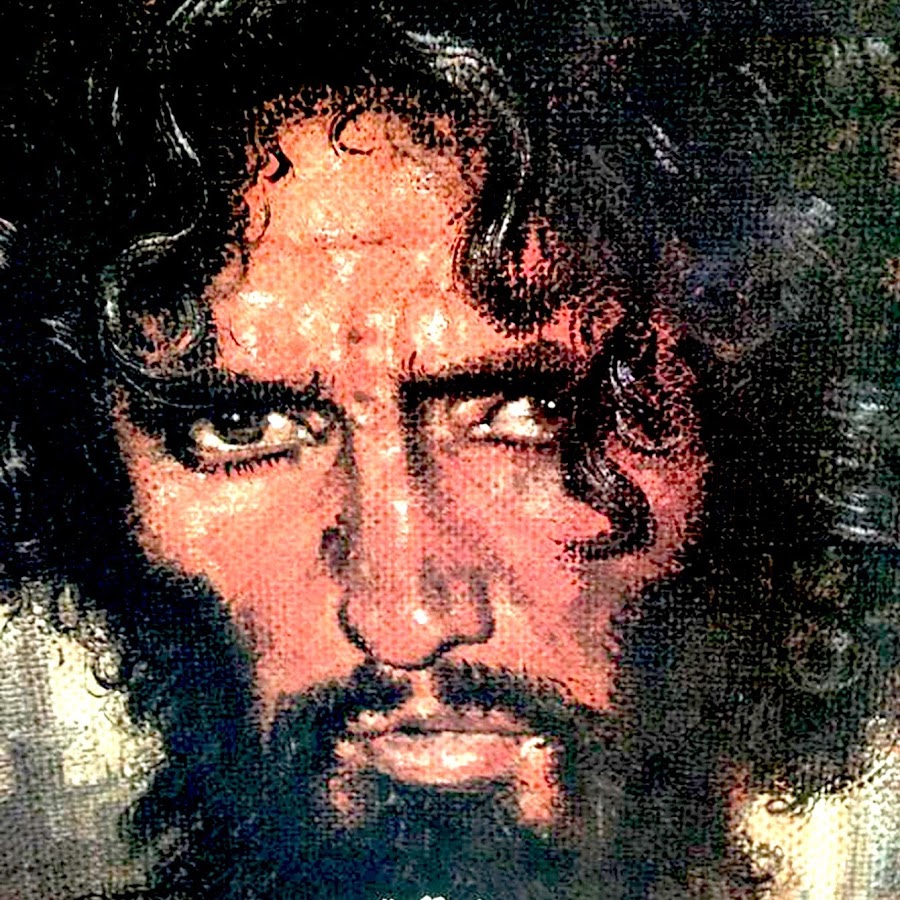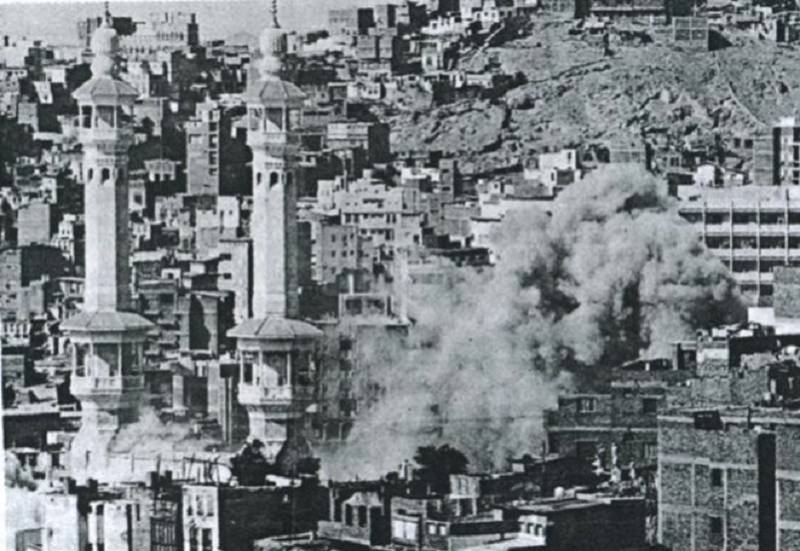
In 2010, I met a carpenter named Mateeullah (aka Matee Ghara). 'Ghara' in Urdu means carpenter. Matee at the time seemed to be in his early 70s. He was from my ancestral hometown, Makhad in the Attock District of Pakistan. Matee was hired as a carpenter by my paternal grandfather in the early 1960s to work in the textile mill which my grandfather and his brothers were setting up in Karachi at the time.
Matee Ghara quit the job at the factory in the late 1960s when I was born. He remembered me well, even though I had no recollection of him. Matee had quit because he had managed to bag a job in Makkah, the Muslim holy city in the Kingdom of Saudi Arabia. However, I did remember him visiting my grandfather once, sometime in the mid-1980s. But when I mentioned this to him, he actually became sad. Surprised by his reaction, I asked whether I had triggered a memory he’d rather not talk about.
‘No, no, puttar (son) …’ he responded in Punjabi. ‘I had come to your grandfather to ask him to help me look for my son, Munir.’
I asked him what happened to his son.
‘He was beheaded in Saudi Arabia …!’ He replied, his voice still heavy with grief.
He then added: ‘But at the time (in the early 1980s), I did not know this. The Saudis refused to tell me and the Pakistani Embassy told me they had no clue where my son had vanished.’
Matee Ghara, an expert carpenter, had quit his job in Karachi and moved to Makkah with his wife and three young sons. In 1969, he bagged a job at a fledgling furniture factory in Makkah which was owned by a minor Arab prince and managed by a former Pakistani trader. Matee was one of the earliest Pakistanis to travel to an oil-rich Arab country for work.
‘There were hardly any Pakistanis in Saudi Arabia when I reached there,’ Matee had told me. ‘That country was still barren and flat with very few tall buildings and roads.’
But all this was about to change. In 1964, when one of the more enterprising sons of the founder of the Saudi monarchy became king, he came in with a vision to transform Saudi Arabia into a powerful political player in the world; an ambition built upon the wealth that the desert kingdom had begun to pile after oil was discovered here in 1938. That son was Faisal. He had replaced his brother, King Saud, who in turn had ascended to the thrown in 1953 after King Abdulaziz (the founder of the Saud monarchy) had passed away.
Faisal had been critical of his brother Saud, often accusing him of floundering Saudi money, and mismanaging the country’s economy.[1] In 1963, Faisal pulled off a quiet palace coup which sidelined his brother.[2] By 1964, he was the new King of Saudi Arabia: King Faisal bin Abdulaziz.
Faisal was perturbed by the fact that even though his kingdom was made up of lands and sites from where Islam had originally emerged (in 7th century CE), the Muslim world (at the time) was being dominated by men such as the ‘secular’ Egyptian ruler and leader, Gamal Abdel Nasser; and by left-leaning ideologies such as Ba’ath Socialism and Arab Nationalism that had glued together socialist concepts with populist nationalism and Islamic symbolism.[3]
As a response, Faisal welcomed members of Egypt’s radical Muslim Brotherhood who had either escaped or were expelled from Nasser’s Egypt. Faisal planned to counter Arab Nationalism by promoting his version of ‘Pan-Islamism’ and for this, he was willing to use his kingdom’s oil wealth. But such plans would take some time to materialize. So, Faisal began to concentrate on his other idea to counter Nasser. He began to ‘modernize’ Saudi Arabia.
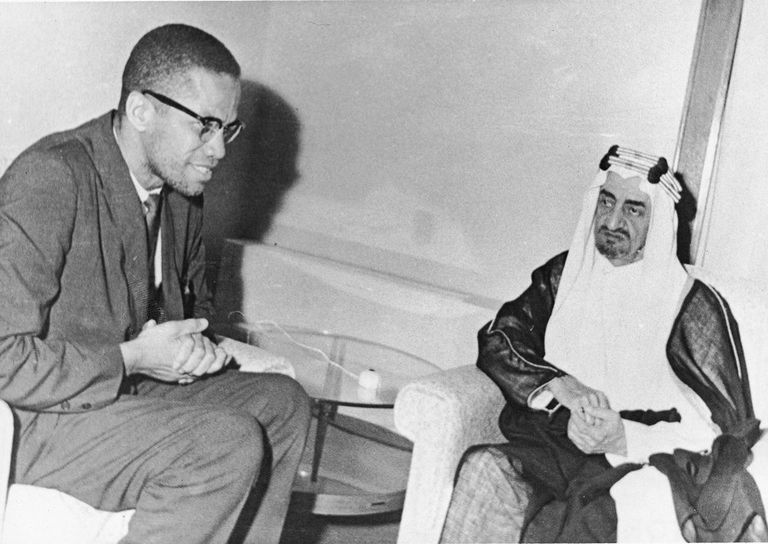
King Faisal with radical African-American convert, Malcom X in 1964.
Faisal allowed a large number of American and European companies and technicians to set up shop in the kingdom and build for him modern highways, roads, boulevards and buildings. This move by him was denounced by the powerful religious figureheads who had been empowered by his father, Abdulaziz. Though American and British technicians and businessmen (especially those related to the oil industry) had often visited Saudi Arabia during Abdulaziz’s time as well, the number of westerners visiting and working in Saudi Arabia increased dramatically during the Faisal era.
Faisal was desperate to modernize Saudi Arabia because Nasser in Egypt and secular Arab regimes in Iraq, Syria, Algeria and Tunisia had all described Saudi Arabia as ‘a regressive feudal/tribal backwater (that was ill-suited to represent the Muslim world in an era of modern progress).’ [4]
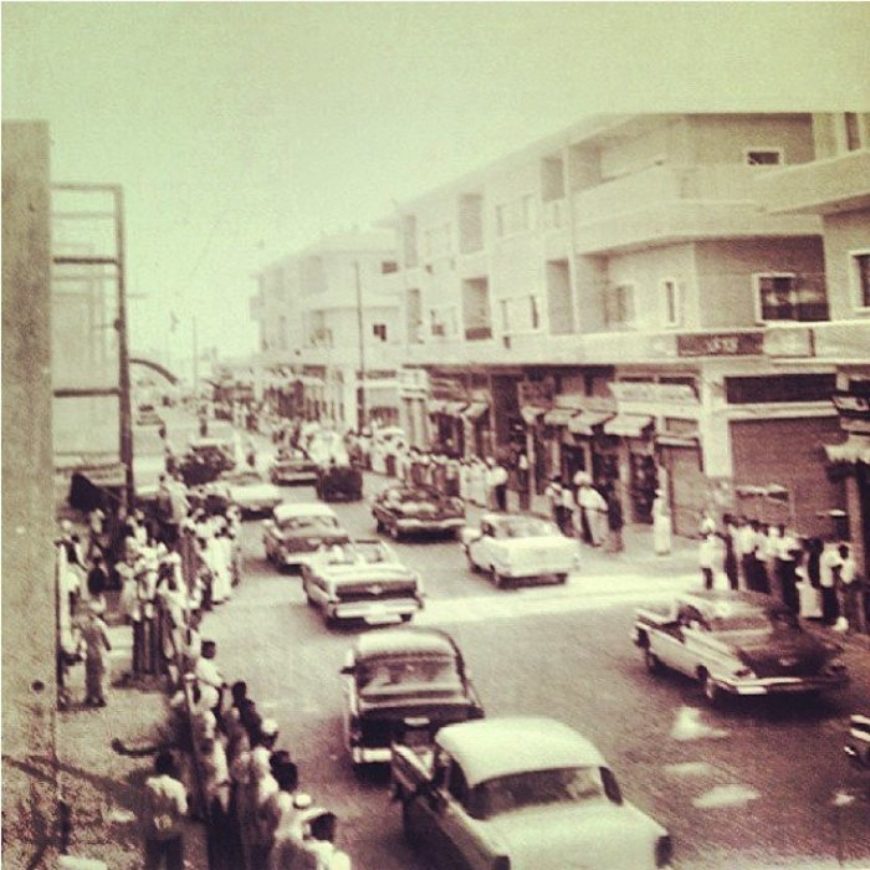
Makkah in the 1960s.
But Faisal had to be careful about how much he could modernize Saudi Arabia. His father had constructed a monarchy with the help of insurgents and fighters made up of fanatical Bedouins called the Ikhwan (the brotherhood).[5] Abdulaziz had used the Ikhwan to defeat rival tribes and finally the Jordanian Hashmite ruler of Makkah in 1926 to become king of a land he renamed Saudi Arabia (after the Saud tribe that Abdulaziz belonged to).[6]
The Ikhwan were followers of a particularly strict and puritanical strand of Islam which some call ‘Wahabism.’ In the 1930s when oil was discovered in the land and Abdulaziz began receiving Western businessmen and technicians, the Ikhwan accused him of betraying their trust by ‘dealing with the devil.’ [7] Abdulaziz tried to appease the Ikhwan by insisting that Saudi Arabia was to be an entirely ‘Islamic abode’ with strict sharia laws; and that for Saudi Arabia’s new-found oil wealth to be managed well, he needed western expertise and personnel.
But the Ikhwan were unmoved. They threatened to break away from the orbit of the Abdulaziz monarchy and attack the westerners ‘polluting the holy land.’ Abdulziz was alarmed by the reaction and asked British warplanes stationed in Iraq to bomb Ikhwan strongholds near the Saudi-Iraq border.[8] Hundreds were killed in the bombing, triggering an all-out revolt by the Ikhwan against the monarchy. Then, Saudi troops and the Ikhwan came face-to-face in a decisive battle around the oasis of Nejdi. Saudi troops armed with latest British weapons mercilessly cut down the Ikhwan and crushed the rebellion.[9]
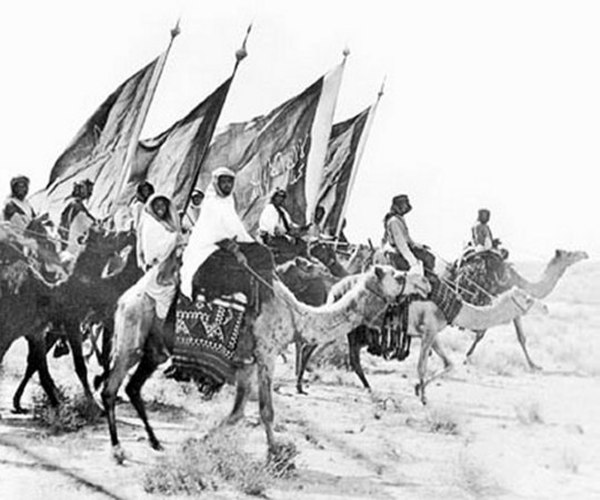
The Ikhwan advance to battle Saudi forces. They were crushed with the help of the British.
The few Ikhwan members who managed to survive the rout were allowed to lead quiet lives in the desert. One such man was Mohammad bin Seif.[10] In the 1920s, he had been a commander in Abdulaziz’s Ikhwan troops. Seven years after the Ikhwan defeat at the hands of the Saudi army, Seif got married and was blessed with a son. He named him Juhayman. After crushing the Ikhwan, Abdulaziz allowed the formation of a powerful group of clerics who would advise the monarchy on the implementation of Islamic laws but were not permitted to ever criticize the king. The group was led by a blind cleric called Ibn Baz.[11]
In the 1940s, Ibn Baz expressed his concern about how the holy land was being allowed to receive ‘infidels’ (westerners).[12] He was promptly arrested and jailed. But he was soon released, and, ironically, was made the regime’s official religious figurehead after he agreed not to criticize the monarchy.[13]
He was, however, allowed (and even encouraged) to deliver fiery sermons in the Grand Mosque of Makkah against ‘communists’, who he believed had infiltrated and taken over the minds of the Muslims in other Arab countries. He also often raged against ‘the obscenities of modernity’ that were never to be allowed to enter the holy land.
So when Faisal began his modernization project, the powerful Ibn Baz was not amused. Faisal largely ignored Baz as long as he didn’t pose any direct threat to the Saudi monarchy.
Matee Ghara remembered visiting the Grand Mosque in the late 1960s and hearing Bin Baz speak. He told me: ‘Baz was not very happy with Faisal. He never attacked him directly, but kept saying that the holy land was being turned into a playground of the devil.’ Matee continued: ‘in the next few years (i.e. by the early 1970s), Saudi cities began to change and grow. More and more foreigners (including South Asians and Africans) started to arrive (for work), and brand new roads and buildings emerged. The number of people visiting Makkah to perform Hajj also doubled.’
Matee added: ‘Faisal was very popular among most Saudis, especially young Saudis. But we, Pakistanis, and people from other poor Muslim countries who had settled in Saudi Arabia also loved him dearly. He was creating new jobs and my three sons got a good education in an Iranian school, even though we were Sunnis. But in those days, Iran was under the Shah and Iranian schools only taught non-religious subjects. There was no Pakistani school in Saudi Arabia in those days.’

Ibn Baz
In 1973, when Matee’s oldest son Munir turned 16, his mother implored him to get his religious education from a Pakistani Islamic evangelist. The evangelist had been invited by the Saudi regime to set up a religious school for South Asian Muslims in Makkah.
‘Munir began attending this school (in 1973),’ Matee informed me. ‘But slowly, he began to question the way we had been practicing our faith. He told us that Pakistanis didn’t know anything about Islam and were committing sin after sin. I was doing well and my family was now settled, so I just thanked the Almighty (Rab) and ignored Munir.’
He continued: ‘But I became angry when one day, he (Munir) insisted that his younger brothers be taken out from the Iranian school. I asked him where else will they study. They were not allowed to go to Saudi schools and, anyway, they didn’t know how to speak or understand Arabic. At least the Iranian school was mostly teaching them in English. The western schools set up by European and American expats were too expensive. But Munir said they (his brothers) didn’t need to learn nonsense like history and science and told me to put them with him in the school that he had begun to attend (on his mother’s insistence). He said religious studies are all a person needs. The tension between him and me became so strenuous over this issue that I pulled my other sons out of the Iranian school and sent them back to Pakistan to live with their grandparents in our village. There they went to a government school for a while, but dropped out and became farmers. I destroyed their future …’
Saudi Arabia enjoyed a windfall of profits when it increased oil prices after the 1973 Egypt-Israel War.[14] Nasser in Egypt had passed away in 1970 and his successor, Anwar Sadat, enjoyed a sudden burst of popularity when Egyptian and Syrian forces managed to achieve some victories against Israeli forces with Soviet-made jets and artillery.
However, the United States quickly reinforced Israeli forces and they rebounded by pushing back the combined Egyptian-Syrian armies. This was Faisal’s moment to strike and emerge as the Muslim world’s new leader. He stopped oil supplies to the US and other European countries supporting Israel. The US economy, heavily dependent on Saudi oil, began to buckle.[15] The US was thus forced to ask Israeli forces to fall back. Faisal slowed down oil production and tripled the price of oil, enjoying massive profits.[16]
Watching Faisal emerge as a hero (and now loaded with a windfall of ‘Petro-Dollars’), Egypt’s Sadat began to warm up to him. Faisal promised to reconstruct Egyptian economy but only if Sadat would let go of ‘Nasserism.’ Almost immediately, Sadat expelled Soviet military and technical advisors from Egypt and broke away from the Soviet camp.[17] He also allowed the expelled members of the Muslim Brotherhood to return to Egypt.
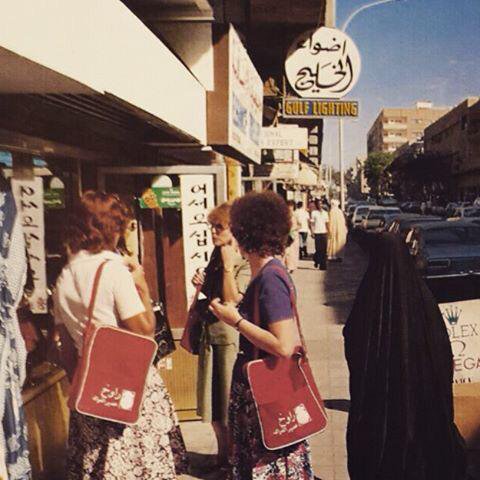
Western shoppers in Saudi Arabia’s Khobar city in 1974.
Matee remembered all this: ‘Munir came one day and told us he was going to Cairo with some friends. Much later, we found out that the friends all belonged to the Muslim Brotherhood. Some of them were his teachers in the school. They were recruiting Pakistanis to set up Muslim Brotherhood branches in Pakistan. But those who tried were arrested by the Bhutto regime. Munir told us Bhutto was playing a double game. On the one hand (like Sadat), he had come under the influence of Faisal, while on the other hand (unlike Sadat), he wasn’t allowing pro-Saudi organizations like the Muslim Brotherhood to operate in Pakistan. Munir was very angry. He said Bhutto was willing to allow Palestinian outfits to open offices in Pakistan. When Munir returned to Saudi Arabia after his trip to Cairo, Munir said Sadat too was not sincere…’
But this didn’t mean Munir was a fan of King Faisal. Matee told me that (according to Munir), Faisal was throwing around money to make his regime politically influential in the Muslim world, but doing nothing for religion: ‘I started to become very concerned about Munir,’ Matee said. He added: ‘At the school, Munir was learning no skills, nothing except a mixture of some form of our faith and some brand of politics,’ Matee remembered.
‘I asked him what he wanted to do, and how he will support himself and his future wife and children. But he just didn’t care and kept saying he only wanted to serve his faith. My wife was very religious, but she was not amused when her teenage son began telling her the correct way of saying her prayers. He also told us not to indulge in indecencies like watching TV, listening to the radio and all. I got really sick of it and told him there was not much happening in Saudi Arabia anyway. TV just had Ibn Baz lectures and the radio was all in Arabic. And I shouted at him for calling us indecent. He was unmoved and kept at it until one day I went to his school and told the principal (an Egyptian) that I wanted to pull out my son from the school. Two days later, I was visited by two Pakistanis and a Bangladeshi and warned that my action of pulling out my son would be seen as a rebellious act against the Saudi regime. They asked me to be grateful that my son was being put on the correct path. Then another two days later, a hefty Saudi man came, and, in broken Urdu, told me to let my son be and never admonish him. I was stunned. I didn’t know who this Saudi was.’
In 1975, Faisal was assassinated. According to the official version, he was killed by a ‘deranged’ young brother of a man who had been shot dead by Saudi police during a riot in 1965.[18] The riots had started in Riyadh by the followers of Baz when Faisal had launched Saudi Arabia’s first TV station. However, conspiracy theorists suggested (and they still do) that Faisal was murdered by the American CIA because the US government was simmering due to the manner in which Faisal had used the power of oil to browbeat the West[19] after the 1973 Arab-Israel War.
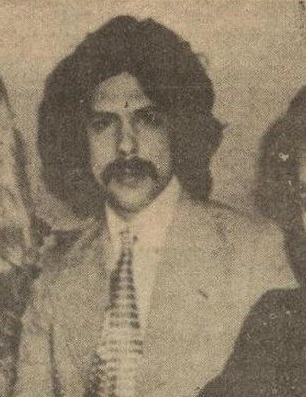
Ibn Masuaid, the young man from a millionaire Saudi family, who assassinated Faisal. He had been living in the US before he was deported back to Saudi Arabia after being arrested in the US for selling drugs. His brother was a religious radical who was killed by the police for protesting against the introduction of TV in Saudi Arabia in 1965.
‘There was great sadness all over,’ Matee remembers. ‘He (Faisal) was such a great man. Had he lived, Saudi Arabia would be so different. Pakistanis were treated in the friendliest manner during his rule. We were treated very badly after he passed away.’
How did Munir react, I asked him.
‘By then (1975), we hardly saw him. One day he came home and said that Faisal had destroyed Saudi Arabia. He said he had made it corrupt and unholy. But what perturbed me most was when he said that now the holy land will be cleansed from all corruption. I asked him did he mean the new king, Khalid (Faisal’s brother). He just scoffed at me and said that the cleansing can’t be done by a king, but by a pious man chosen by God …’
Juhayman, the son of the defeated Ikhwan fighter, was born in the late 1930s. He lived with his parents as a Bedouin in the desert. He was never formally educated but did receive some religious education. He grew up hearing stories of how the Ikhwan had laid down their lives to bring the Saud family to power and then how they were wiped out by the same family.[20]
Juhayman joined the Saudi Guardsman as a truck driver.[21] The Guardsman was a small government force positioned in the Kingdom’s far-flung and less developed areas. On the side, Juhayman ran a tiny clandestine business, smuggling in cigarettes (on camels) from Kuwait.[22]
In 1973, he quit the Guardsman and came to Medina, where he lived in a small rundown apartment. He began to regularly visit the Islamic University in Medina, where Ibn Baz would often deliver his fiery sermons. By now Baz had become the most influential cleric in the Kingdom, though he was still on the payroll of the monarchy.
During the Faisal regime, Baz would only indirectly criticize Faisal’s modernization project. But when Khalid took over as King, his younger brother, Crown Prince Fahad, put more wheels on the project that Faisal had started, and initiated the emergence of shopping malls in Makkah and Medina and American soap operas on Saudi TV. Fahad also gathered a reputation of being a ‘playboy prince’.[23]
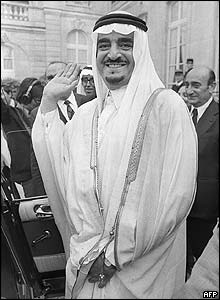
Faisal’s brother Fahad in 1975. He became Crown Prince after Faisal’s assassination and sped up Faisal’s ‘modernization’ program.
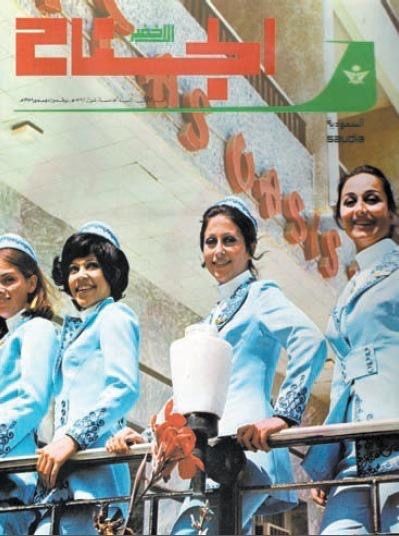
A 1976 Saudi Airlines ad.
Baz was livid. In his lectures at the Islamic University, he began to directly attack Khalid and Fahad. He went to the extent of asking the government to ban cigarettes and even clapping in public![24] Faisal had allowed Saudi women to work in offices. Khalid accelerated this policy, leaving Baz complaining that ‘this act (of allowing women to work) was inspired by Satan.’[25]
But since most of Baz’s audiences (at the University) were made up of exiled Muslims from other countries and a few disaffected Saudis (like Juhayman), Khalid did not take any action against him. In 1976, Baz decided to form a missionary organization that pledged to halt the wave of ‘abominations’ being introduced by the monarchy, and to reinstate the ‘true faith of the Saudis in the holy land.’
The outfit was called Dawa Salafiya[26] and it began to recruit and send missionaries across the Kingdom. Juayman became one such missionary. He rose quickly through the ranks of the outfit. By 1977, the Dawa had become a powerful missionary outfit, headed by Baz, and having in its ranks thousands of Saudis. But it also included Yemenis, Pakistanis, Muslim Indians, Bangladeshis, Sudanese, Somalis, Egyptians and even a few Afro-American Muslim converts.
Matee told me: ‘Years later we discovered that Munir too had joined Baz’s organization. It (the organization) was recruiting common Saudis and young non-Saudi Muslims working in Saudi Arabia, but they also began visiting religious schools like the one attended by my son; and (with the help of the school’s administration), the organization began to attract educated young men like Munir. We hardly saw him anymore. We had no clue what he was up to.’
In 1978, Juhayman had a falling out with the Dawa.[27] He criticized Baz for continuing to be on the payroll of the monarchy. Baz explained to him that the monarchy might be corrupt and the princes may be playboys, but the monarchy remained to be a barrier against communism in the region. Juhayman scoffed at this explanation and quit the organization. With him also went some other members of the organization, one of them being Munir.
‘Munir never spoke of Juhayman,’ Matee told me. ‘He would just talk about some pious Saudi man who would cleanse the holy land. It was only latter that we realized that he was talking about Juhayman.’
Juhayman now began to write and publish long essays against the ‘corruption of the monarchy,’ the sacrilege of the holy land by Saudi princes, and ‘their infidel guests,’ and also about how clerics like Baz were not practicing what they were preaching.
Juhayman soon came under the radar of the Saudi police, especially when he began to talk to the members of the Egyptian Muslim Brotherhood (settled in Saudi Arabia) about how they planned to topple Sadat. Most of Juhayman’s followers were young Saudis who had come from poor Bedouin families.
They had arrived in the Kingdom’s big cities to benefit from the rapid pace of modernization, but had been left feeling alienated and disorientated. Others came from working-class groups of non-Saudi Muslims from various South Asian and African countries.
In late 1977, Juhayman formed a clandestine organization. He told his followers to shun all material luxuries. The members also let their hair and beards grow, and walked around in dusty white robes preaching ‘the true word of God.’[28] They destroyed their identity cards and formed communes in Makkah, Medina and Riyadh, where they lived, ate and prayed together.
The Saudi government finally acted and arrested some members of Juhayman’s group. But Baz came to their rescue and ordered their release. The Saudi regime obliged. Then, in November 1978, the brother of one of Juhayman’s closest aides, Mohammed Abdullah al-Qahtanithat, began to allude that his brother was the Mahdi[29] (the mythical warrior-savior who according to some Islamic traditions would appear to spread God’s laws on Earth).
Juhayman went along with the façade. It was helpful to his cause. It gave his movement a messianic sheen. Juhayman began to tell his followers to prepare for a showdown with the unholy forces of tyranny, obscenity and greed. The group began to amass weapons. The weapons were first stolen from the armories of the Guardsmen by Juhayman’s followers in the paramilitary outfit.[30] Then more rifles and machine guns were smuggled in from Yemen. Bombs and even more guns were bought from the black market[31] that was then crammed with weaponry smuggled in from Lebanon, a country that had collapsed into a lethal civil war.
In late 1978, Juhayman quoted an obscure hadith foretelling the arrival of the Mahdi who would fight anti-Islam forces from the Grand Mosque in Makkah. The Mosque was located at the location of the most sacred Islamic site, the Ka'aba. On November 20, 1979, as the grand mufti of the mosque was preparing to lead the morning prayers that were being attended by thousands of Muslims from across the world, Juhayman led some 500 of his followers, all heavily armed, to barge into the mosque and seize it.
His followers who entered the mosque also included a dozen or so veiled women who had joined his movement. Juhayman cut off the telephone lines, allowed many worshippers to leave the mosque, but retained hundreds of others as hostages. He put expert marksmen on the roofs who then easily repulsed the Saudi regime’s first attempt to take back the mosque. Dozens of Saudi policemen and troops were cut down by heavy machine gun fire from Juhayman’s men.[32]
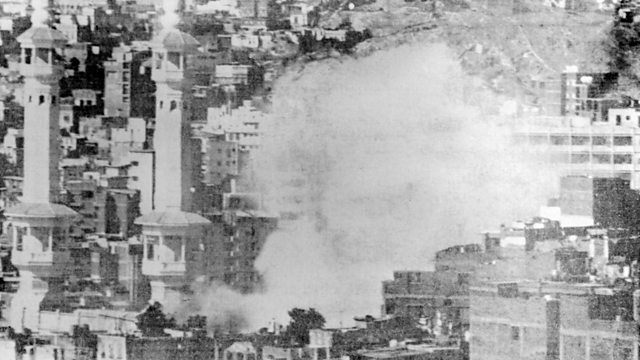
Smoke rises from the Grand Mosque in Makkah.
Matee was in Riyadh at the time. He told me: ‘I was in Riyadh for some work. My wife called at a relative’s apartment where I was staying. She told him she could see smoke rising from the Ka'aba. But then the line got disconnected and my relative just couldn’t call her back. The phone lines went dead. Then we began to hear murmurings about an attack on Ka'aba. I was scared. Nobody was saying a word about it on the TV or the radio. I hurried back to Makkah on a taxi driven by a Pakistani. He told me the airports were being shut down. When I reached home the next day, indeed, I too could see smoke rising from my apartment window. Then police vans appeared and began announcing that everyone should remain indoors. I panicked. I thought of Munir. I knew he prayed regularly at the mosque. My wife begged me to fetch him. I ran down and headed towards the school. It was sealed and being guarded by Saudi soldiers. One officer told me to go back because there was no one there. I began to shout, ‘Munir, Munir!’ The soldiers started to push me inside a waiting army truck, but I dodged them and ran back home …’
The Saudi regime summoned its leading religious figurehead, Ibn Baz, and other official clerics to issue a fatwa against the attackers, which they did.[33] With a fatwa in hand (sanctioning Saudi soldiers to enter the holy premises with weapons), troops moved again to retake the mosque. But once again they were repelled by machinegun fire and grenades. Dozens more lay dead. The Saudi regime began to panic. It blacked-out all news going out from the besieged kingdom.
Matee told me: ‘For days the whole country just stood still. The TV and radio went blank. We couldn’t even tune into the BBC (radio). Phones were dead. All we heard was gunfire. Nobody spoke. Nobody was allowed to speak. But one day, our phone suddenly rang. The operator said the call was from Pakistan. It was my mother. The phones were back on. She asked us what was happening. We told her we had no clue. She said that the American Embassy in Islamabad had been burned down. I was shocked. Was it the Americans attacking the Ka'aba? The phones went dead again.’
Pakistan’s state-owned TV channel the PTV was telecasting a cricket Test match between Pakistan and India being played in the Indian city of Bangalore on the day of the siege. The transmission was suddenly interrupted and the newscaster, Azhar Lodhi, appeared on the screen. In a somber tone, he announced the attack on Ka'aba without giving any details about the attackers. PTV did not return to the Test match; instead it started to run recitations from the Quran.
PTV did not announce that the attackers were all Muslim. Pakistanis tuned into BBC Radio’s Urdu service that quoted the official Iranian media that was now under the control of an Islamic revolutionary government in Tehran. The reported quote suggested that the attacks were the work of the ‘American-Zionist lobby.’
The very next day, large rallies condemning the siege appeared in major Pakistani cities. The biggest rally took place in the country’s capital, Islamabad. It was a spontaneous gathering held outside the American embassy building. It suddenly turned violent when some students made fiery speeches, blaming the United States for the attack on the Ka'aba.
The gathering soon turned into a rampaging mob which forced its way inside the embassy’s compound and offices.[34] The mob was acting upon what it had heard on the BBC believing that the Iranian quote that the radio network had used was actual news.
The Iranians were well aware of the reality behind the takeover of the mosque by Saudi fanatics. But they used the opportunity to embarrass both the Americans and the Saudi monarchy by claiming that it was a part of a US plot to ‘occupy’ Makkah. The Zia regime, unimpressed by American criticism of its takeover (in 1977), and facing American sanctions, did not reveal the details of the attack to the public at large.
Suddenly, unchecked by the Zia regime, the news broadcast by Iranian radio that was then reproduced by some Urdu newspapers in Pakistan was used as a plank to organize a sit-in outside the US embassy in Islamabad. The sit-in was then infiltrated by some boisterous young men who instigated the gathered people to attack the embassy. The mob surged forward towards the embassy, setting it on fire. The attack lasted for hours, but the police stayed put.[35]
Pakistan Army helicopters hovered over the burning building and only landed on the roof of the crumbling structure after the mob had already killed two Americans and two Pakistani employees of the embassy. Two protesters also lost their lives in the chaos. The violence and the rallies finally came to a sudden halt once the Zia regime decided to release the full details of the attack in Makkah.
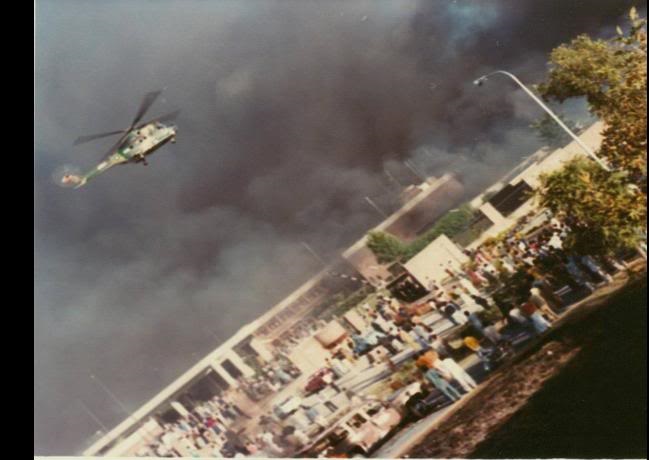
A military helicopter hovers over the burning US Embassy building in Islamabad (November, 1979).
After three more raids by Saudi forces were repulsed by Juhayman’s men, the Saudi regime contacted the French for help.[36] The Saudis had earlier declined Jordanian and Pakistani offers to use their armies to enter the mosque.[37] The French sent three senior commandos of the French army to oversee a plan to break the siege.[38] Saudi troops, now working under the instructions of the French military experts, tried again.
After days of intense fighting, Saudi troops finally managed to break in. Over 255 people died. This included dozens of pilgrims who were being held inside the mosque as hostages. Over 500 were injured. 127 Saudi soldiers were killed.[39] Though most of Juayman’s men were also killed, Juayman and about 67 of his followers who survived the counterattack were arrested. In January 1980, they were all beheaded.
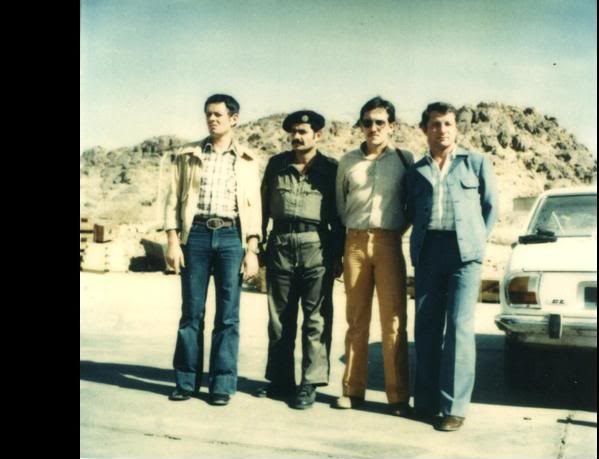
French commandos with a Saudi officer in the outskirts of Makkah from where they directed the operation against Juhayman’s men.
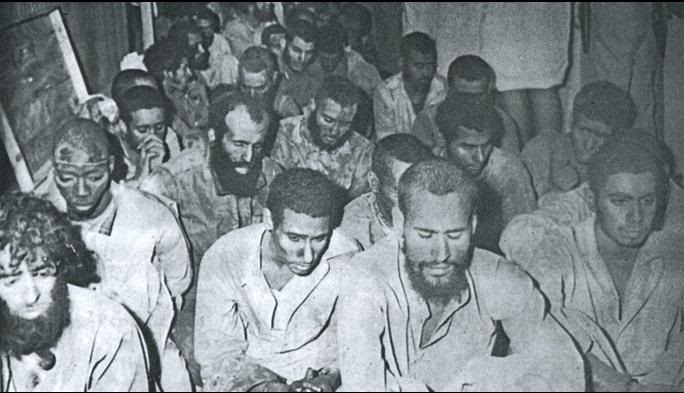
Some of Juhayman’s men, arrested.
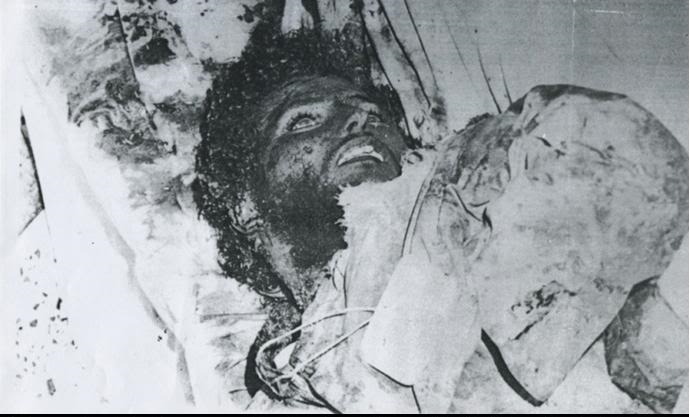
Body of Muhammad Abdullah who claimed he was the Mahdi.
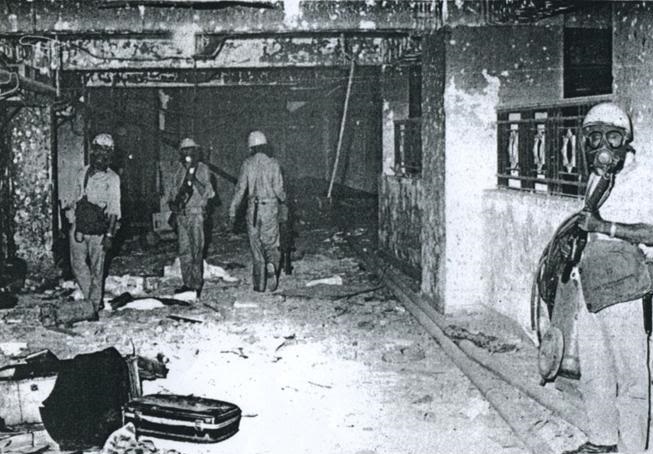
Saudi soldiers in gas masks survey the damage.
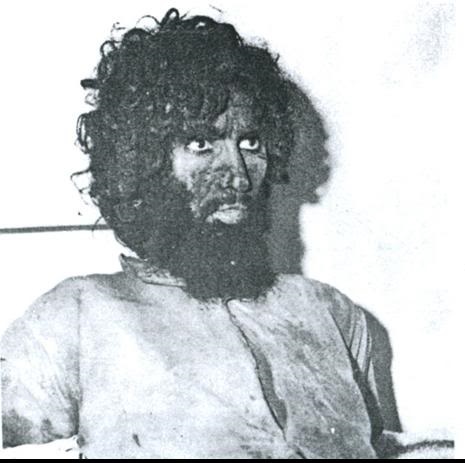
Juhayman captured alive. In 1980 he was beheaded.
Surprisingly, instead of cracking down on anarchic religious outfits, King Khalid did what his father Abdulaziz had done after crushing the Ikhwan. Khalid, too, further empowered the Kingdom’s official hardline clergy. The idea was that this would absorb (and neutralize) any fanatical outbursts against the monarchy.
But in the coming years, this policy would once again backfire when it failed to halt the emergence of extremist outfits generated by the Saudi monarchy’s curious mixture of a puritanical strand of the faith, its appeasement of those who proliferate this strand, and its desire to achieve rapid economic modernization without implementing any social and political reform.
Out of the 500 or so of Juhayman’s men who had seized the mosque, more than 70 per cent were Saudi men. The rest belonged to countries such as Sudan, Yemen, Somalia, Egypt, India, Bangladesh and Pakistan. There were a few African-American converts as well.[40]
Matee never believed his son was involved: ‘When the dust settled, I went looking for Munir again. After months, the Saudis released the list of those killed in the attack. Munir’s name was not on the dead pilgrims’ list. But the Saudis never fully released the names of the militants who were killed inside the mosque or were beheaded by the government. Munir was nowhere.’
Matee returned to Pakistan in 1985.
According to what Matee found out, Munir had been introduced to Juayman’s group by an Egyptian teacher of his at the school. The teacher had been a member of the Muslim Brotherhood and had arrived in Saudi Arabia as an exile in the 1960s. He quit the Brotherhood in the late 1970s and became a recruiter for Juhayman. He convinced Munir to join Juhayman’s cause. Minir gladly went along.
Matee Ghara had told me: ‘I don’t know what role Munir played in all this. My wife kept waiting for him. She said, 'Janat toh maa kay pair talay hoti hey (Heaven is beneath a mother’s feet); what was my son doing looking for it in the ways of a mad man?'’
She passed away in 1994, still hoping that one day her Munir may just come back to her. He didn’t.
References:
[1] Middle East Record Vol: 1, 1960. p.372
[2] Anwar Haroon: History of Saudi Arabia and Wahabism (Xlibris, 2014) p.205
[3] Gad Silbermann: A study of the ideology and policy of Arab socialist regimes (Academic Committee of Middle East, 1973) p.4
[4] Gerhard Böwering, Patricia Crone: Princeton Encyclopedia of Islamic Political Thought (Princeton University Press, 2013) p.486
[5] The Role of the Ikhwan under Abdul Aziz Al-Saud: 1916-34 (University of Durham, 1999)
[6] Ibid.
[7] Ibid.
[8] Ibid.
[9] Jenifer Reed: The Saudi Royal Family (Infobase Publishing, 2009) p.35
[10] Ibrahim Abu-Rabi: Intellectual Origins of Islamic Resurgence in the Modern Arab World (SUNY Press, 1996) p.74
[11] Simon Ross Valentine: Wahabism in Saudi Arabia and Beyond (Oxford University Press, 2014) p.160
[12] Ibid.
[13] Ibid.
[14] Robert Sexton: Exploring Economics (Cengage, 2014) p.392
[15] Rushefsky: Public Policy in the United States (M E Sharpe, 2008) p.56
[16] Karen R. Merrill: The Oil Crisis of 1973-74 (Bedford/St. Martin’s, 2007)
[17] P.R. Kumaraswamy: Revisiting the Yom Kippur War (Routledge, 2013) p.47
[18] Alexei Vassiliev: King Faisal: Personality, Faith & Times (Saqi Publications, 2013)
[19] Ibid.
[20] Thomas Hagghammer, Stephane Lacroix: The Meccan Rebellion (Amal Press, 2011)
[21] Yaroslav Trofimov: The Siege of Mecca (Knopf Doubleday Publishing Group, 2008)
[22] Ibid.
[23] Fahad’s First Months as King: Mark Weston (Wiley, 2011).
[24] Yaroslav Trofimov: The Siege of Mecca (Knopf Doubleday Publishing Group, 2008)
[25] Ibid.
[26] Kai Bird: Divided City: Coming of Age between the Arabs and Israeli (Simon & Schuster Publications, 2010).
[27] Yaroslav Trofimov: The Siege of Mecca (Knopf Doubleday Publishing Group, 2008)
[28] Ibid.
[29] Ibid.
[30] Thomas Hagghammer, Stephane Lacroix: The Meccan Rebellion (Amal Press, 2011
[31] Ibid.
[32] Lawrence Wright: The Looming Tower (Knopf Doubleday Publishing Group, 2006)
[33] Yaroslav Trofimov: The Siege of Mecca (Knopf Doubleday Publishing Group, 2008)
[34] A Day of Terror Recalled: Cameron W. Barr (Washington Post, Nov. 27, 2004)
[35] Ibid.
[36] Yaroslav Trofimov: The Siege of Mecca (Knopf Doubleday Publishing Group, 2008)
[37] Ibid.
[38] Dr. John Calvert: Islamism: A Documentary and Reference Guide (Greenwood Publishing Group, 2006) p.178
[39] Yaroslav Trofimov: The Siege of Mecca (Knopf Doubleday Publishing Group, 2008)
[40] Ibid

